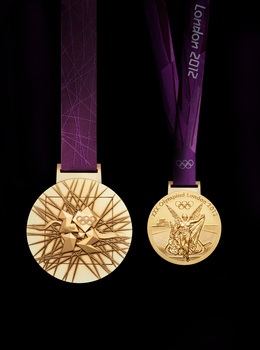The first ‘recorded’ Ancient Olympic Games was held in Olympia, Greece in 776 BC. For nearly 1200 years the Ancient Olympic Games continued to be held every 4 years until it was abolished in, or around 393 AD.
The Olympic Games Committee (IOC), the governing body of the Modern Olympic Games was formed by Baron Pierre de Coubertin in 1894 and to this day, still manages the Olympic Games in-line with the structure and actions defined by the Olympic Charter. It is within the Olympic Charter that the rules, specifications and definitions relating to the ‘modern’ Olympic Medals are maintained. Today, the first, second and third Athletes in each discipline are awarded a Gold, Silver and Bronze medal respectively. But, was this always the case? And, what have the medals traditionally been made of?
Origins of the Olympic Medal
In the Ancient Olympic Games the Champions were presented with a Wreath (traditionally made from Olive branch), placed around the neck of the victor at the closing ceremony. Therefore, we can trace the origins of prize giving for the top performing Olympic Athletes back to its inception.
Currently awarded to the 1st, 2nd and 3rd placed athlete in each discipline, Olympic Medal design and composition has changed considerably since the first ‘modern’ Olympic Games in 1896. In fact, the first medals presented to the winners of the 1896 Olympics were actually made of Solid Silver (Ag, Atomic number 47), and were presented to the victor along with an Olive branch. In the same Olympic Games, the runners-up were awarded a Bronze (Traditionally a mixture of Copper and Tin) medal and a laurel branch.
Strangely, at the 1900 Olympic Games most of the victorious athletes received cups or trophies instead of medals. However the IOC has since awarded Gold, Silver and Bronze medals to all 1st, 2nd and 3rd placed athletes at both the 1896 and 1900 Olympic Games.
The traditional 3 tier (Gold, Silver and Bronze) awards began at the 1904 Olympic Games held in the USA and was adopted by the IOC as the standard format for all Olympic games since. Here you can see the 3 medals for London 2012.

Image Credit: LOCOG 2012
Design and Specification of Olympic Medals
The 1st Olympic Medals (in 1896) were designed and fabricated in Paris, France. Since then, there has been a tradition that the host country’s organising committee is responsible for the aesthetic design and production of the Olympic medals.
However, some standards and specifications must be adhered to. Traditionally for the summer Olympic Games, the front of the medals must feature an image of the Greek God of Victory (Nike) stepping out of the Parthenon to arrive in the Host City.
Along with some fundamental design characteristics the composition, size and weight of Olympic medals are also subject to IOC specifications and rulings.
IOC Design Specifications for Olympic Medals
Recipients – Medals can only be awarded to the top 3 athletes in each discipline
Shape – Traditionally the medal must be circular as a metaphor for the World
Diameter – Minimum of 60mm
Thickness – A Minimum of 3mm
Design – The sport/discipline should be written on each medal
IOC Material Specifications for Olympic Medals
Contrary to popular belief, the Olympic Gold Medal is not made from solid Gold. Below are the specifications as defined by the IOC:
1st Place (Gold Medal): composed of predominantly Silver (Ag Min 92.5%) covered with a min of 6 grams of Gold (Au, Atomic No. 79)
2nd Place (Silver Medal): composed of Silver (Ag Min of 92.5%)
3rd Place (Bronze Medal): composed of Bronze (A mixture of Copper, Zinc and Tin)
The precious metals used in the LOCOG designed London 2012 Olympic medals were supplied by London 2012 sponsor Rio Tinto and were mined in both the USA and Mongolia.
Much of the non-precious metals used in the production of the LOCOG 2012 medals have been sourced from Australia, Recycled stock in the UK and the Tin originates from Cornwall, England.
How Olympic Medals are made?
Olympic medals are manufactured (struck) in the same way that many modern coins are.
Once the final designs have been chosen, the Mint will first replicate each design as a 3D model which is used to create a full size steel mold (or Die) of the medal. The molds (Dies) are then heat treated and hardened ready for the striking process.
The medal material is then formed and shaped into discs with the correct composition, shape, thickness and diameter.
A hydraulic press is then used to press (strike) the discs within the dies, under thousands of pounds of force the medals are fashioned by the images on the inside of the molds.
The pressed medals are then finished by hand and the ‘eye’s for the ribbon are soldered onto each medal and the ribbon fed through.
London 2012 Medal Design

Image Credit: LOCOG 2012
Designed by renowned Decorative Artist David Watkins, the London 2012 Olympic medals are being produced at the Royal Mint headquarters in South Wales.
With the traditional image of Nike (The Greek Goddess of Victory) stepping from the Parthenon into the host city on the front, the reverse of the medal is designed by the host organising committee. In the London 2012 Olympics this responsibility lies with LOCOG.
The LOCOG 2012 Medal Design
- A Curved background symbolising an amphitheatre
- An architectural metaphor of a modern city – deliberately jewel like
- An outreaching grid – a symbol of the radiating energy the games and athletes represent
- The River Thames in the background – a Symbol of London, ribbon like adding a sense of celebration
- A Square – balancing the design and reinforcing the sense of place, much like a map inset.
Sources and Further and Reading